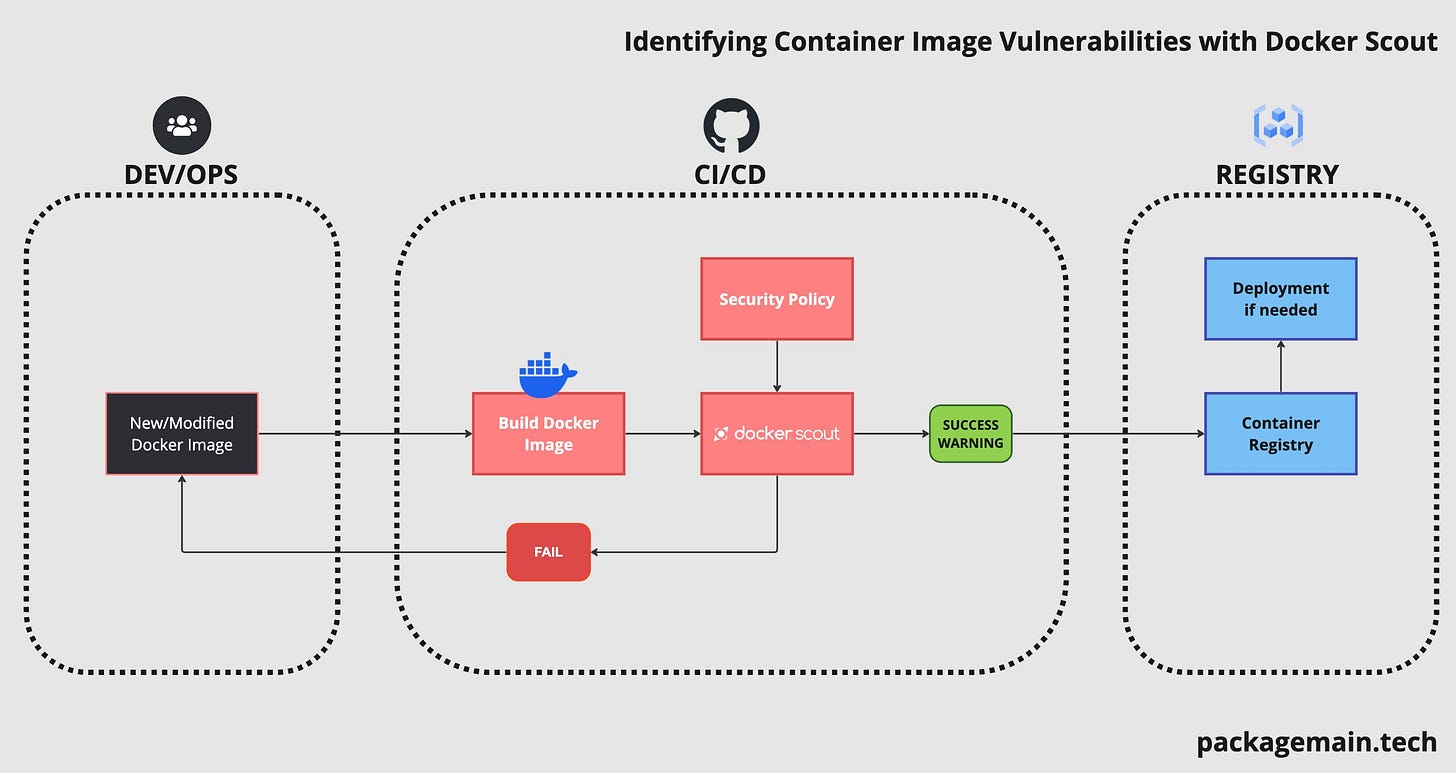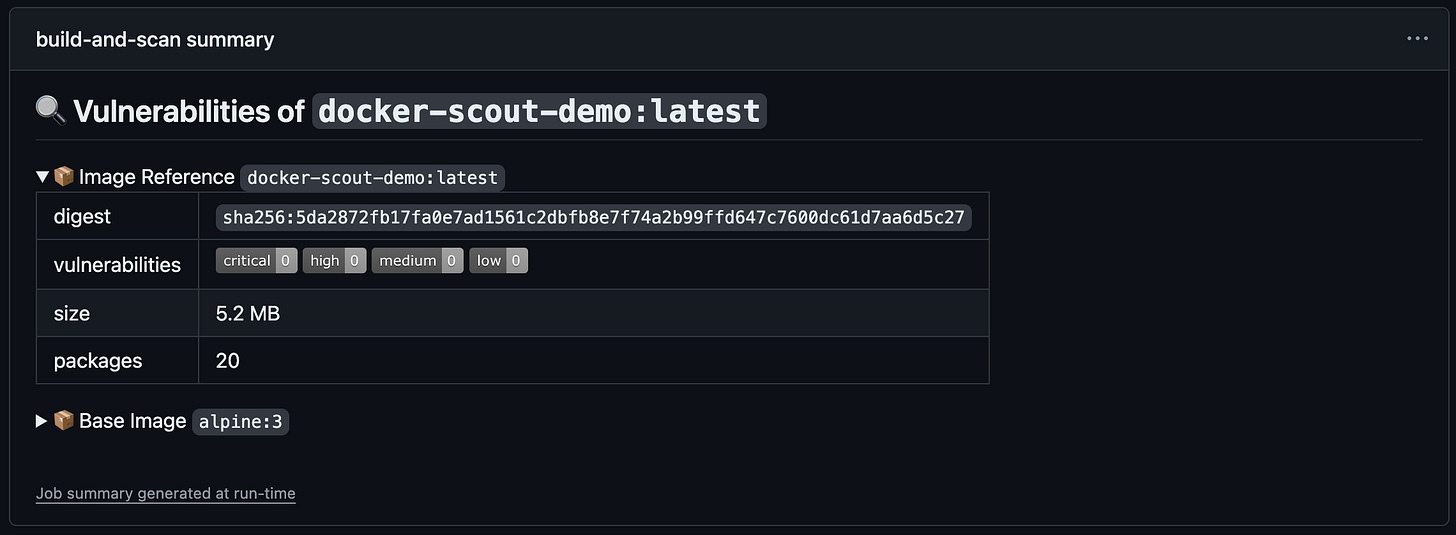Identifying Container Image Vulnerabilities with Docker Scout
A guide on how to maintain a more secure containerized software.
Introduction
We all know, that Docker technology is great and brings us many advantages, but also, unfortunately, Docker images include many attack surfaces on different layers.
Every day, there are new vulnerabilities discovered in open source projects and maintainers are tasked with patching their software. ~30k new vulnerabilities discovered in 2023 alone.
So how can we mitigate this risk? One solution is vulnerability scanning and its integration into your development lifecycle.
There are many free, open-source but also paid tools for Docker vulnerability scanning:
Docker Scout
Aqua Security Trivy
Snyk
tenable.io
and many others…
They all have their advantages and differences, but still share the main goal: identify unpatched vulnerabilities.
Docker Scout Example
Let's take a deep dive into the Docker vulnerability scanning and see it in action! We will:
Craft a sample Dockerfile as a foundation for our exploration.
Scan for vulnerabilities with Docker Scout.
Explore some resolution options.
Set up a simple CI/CD pipeline to automate continuous scanning/reporting.
Our Dockerfile will use golang:1.19 as a base image, which is not the latest version, but not so old either, and I believe many projects still use it.
main.go
package main
import "fmt"
func main() {
fmt.Println("Hello, Stranger!")
}Dockerfile
FROM golang:1.19
WORKDIR /
COPY main.go .
RUN go build -o goapp main.go
CMD ["./goapp"]In order to scan our image, we have to build it first, let's also run it to make sure it works as intended.
docker build -t goapp .
docker run goapp
> Hello, Stranger!Setting up Docker Scout
If you're using a recent version of Docker Desktop, you might already have the Docker Scout command line tool available. While this guide won't endorse any specific tool, Docker Scout can be a handy starting point for this demonstration.
Some notes on Docker Scout:
You need to have a Docker Hub account to run it
Free version has its limitations for remote images
Not many registries are available, for example Google Cloud Container Registry is not available yet
These are the commands to enable Docker Scout:
docker login
docker scout enroll ORG_NAME
docker scout helpDocker Scout Command Line
There are a few commands available:
quickview: get a quick overview of an image, base image and available recommendations
compare: compare an image to a second one (for instance to :latest)
cves: display vulnerabilities of an image
recommendations: display available base image updates and remediation recommendations
We can use them to scan our already built image. Which resulted in...
docker scout cves goapp
80 vulnerabilities found in 25 packages
UNSPECIFIED 11
LOW 46
MEDIUM 12
HIGH 9
CRITICAL 2Quite a lot right? Docker Scout can give us some basic recommendations with recommendations command. In our case it suggests to bump our base image to golang:1.22. Let's try it again.
Dockerfile
FROM golang:1.22
WORKDIR /
COPY main.go .
RUN go build -o goapp main.go
CMD ["./goapp"]59 vulnerabilities found in 23 packages
LOW 55
MEDIUM 1
HIGH 2
CRITICAL 1Much better, but still...
The output also shows us the list of CVEs with their details:
CRITICAL CVE-2024-32002
https://scout.docker.com/v/CVE-2024-32002
Affected range : >=1:2.39.2-1.1
Fixed version : not fixed
...Let's open this Critical CVE-2024-32002. As it turns out it's coming from Git software, but do we actually need Git in our image to run the application? To build probably yes, because we need to download modules and repositories, but since Go is compiled, we don't need Git after our program is compiled.
Multi-stage Docker builds
Multi-stage builds can help us here to separate build and run stages, which also has other benefits such as a smaller image.
Dockerfile
FROM golang:1.22 as builder
WORKDIR /
COPY main.go .
RUN go build -o goapp main.go
FROM alpine:latest
COPY --from=builder /goapp .
CMD ["./goapp"]docker scout cves goapp
No vulnerable packages detectedAwesome, no vulnerabilities were identified! Or at least we may think so and have some peace of mind :)
Integrating into CI/CD
While manual scanning is valuable, integrating vulnerability checks into your CI/CD pipeline is crucial for serious vulnerability management. This ensures automated scanning for every build, preventing malicious software from reaching production.
Docker Scout has a GitHub Action to run the Docker Scout CLI as part of your workflows.
Here is an example workflow which runs Docker Scout on every push and reports only Critical and High vulnerabilities as a comment.
.github/workflows/docker-scout.yaml
name: Docker Scout
on:
push:
branches:
- "*"
jobs:
build-and-scan:
runs-on: ubuntu-latest
steps:
- name: Checkout repository
uses: actions/checkout@v4
- name: Setup Docker buildx
uses: docker/setup-buildx-action@v3
- name: Build Docker image
uses: docker/build-push-action@v4.0.0
with:
context: .
push: false
load: true
tags: ${{ github.event.repository.name }}
- name: Login to Docker Hub
uses: docker/login-action@v3
with:
username: ${{ secrets.DOCKERHUB_USERNAME }}
password: ${{ secrets.DOCKERHUB_TOKEN }}
- name: Docker Scout
id: docker-scout
uses: docker/scout-action@v1
with:
command: cves
image: ${{ github.event.repository.name }}
ignore-unchanged: true
only-severities: critical,high
write-comment: true
github-token: ${{ secrets.GITHUB_TOKEN }}Some notes on this Github Actions:
It requires authentication to Docker Hub, so we should add DOCKERHUB_USERNAME and DOCKERHUB_TOKEN to repository secrets.
We set push: false not to push image to the repository, as we scan it locally
Incorporating these practices into your workflow empowers developers to streamline vulnerability management and maintain a more secure containerized software.






Great article. I would like to suggest that the steps to reduce CVEs described here are only some of the possible solutions. I personally discovered distroless containers and Chainguard images to be reducing the CVEs to 0 in most cases without code changes or even complex multi stage builds.
I wrote an article about it at https://cloudnativeengineer.substack.com/p/shrink-to-secure-kubernetes-and-compact-containers-296b67d9975a